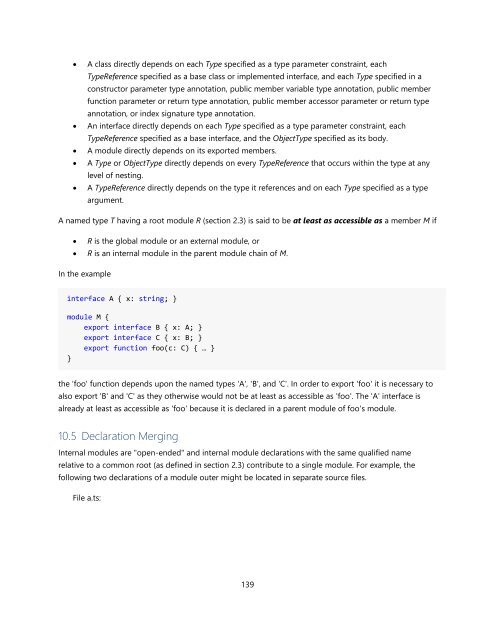TypeScript Language Specification v1.5
TypeScript Language Specification v1.5
TypeScript Language Specification v1.5
You also want an ePaper? Increase the reach of your titles
YUMPU automatically turns print PDFs into web optimized ePapers that Google loves.
A class directly depends on each Type specified as a type parameter constraint, each<br />
TypeReference specified as a base class or implemented interface, and each Type specified in a<br />
constructor parameter type annotation, public member variable type annotation, public member<br />
function parameter or return type annotation, public member accessor parameter or return type<br />
annotation, or index signature type annotation.<br />
An interface directly depends on each Type specified as a type parameter constraint, each<br />
TypeReference specified as a base interface, and the ObjectType specified as its body.<br />
A module directly depends on its exported members.<br />
A Type or ObjectType directly depends on every TypeReference that occurs within the type at any<br />
level of nesting.<br />
A TypeReference directly depends on the type it references and on each Type specified as a type<br />
argument.<br />
A named type T having a root module R (section 2.3) is said to be at least as accessible as a member M if<br />
R is the global module or an external module, or<br />
R is an internal module in the parent module chain of M.<br />
In the example<br />
interface A { x: string; }<br />
module M {<br />
export interface B { x: A; }<br />
export interface C { x: B; }<br />
export function foo(c: C) { … }<br />
}<br />
the 'foo' function depends upon the named types 'A', 'B', and 'C'. In order to export 'foo' it is necessary to<br />
also export 'B' and 'C' as they otherwise would not be at least as accessible as 'foo'. The 'A' interface is<br />
already at least as accessible as 'foo' because it is declared in a parent module of foo's module.<br />
10.5 Declaration Merging<br />
Internal modules are "open-ended" and internal module declarations with the same qualified name<br />
relative to a common root (as defined in section 2.3) contribute to a single module. For example, the<br />
following two declarations of a module outer might be located in separate source files.<br />
File a.ts:<br />
139


















